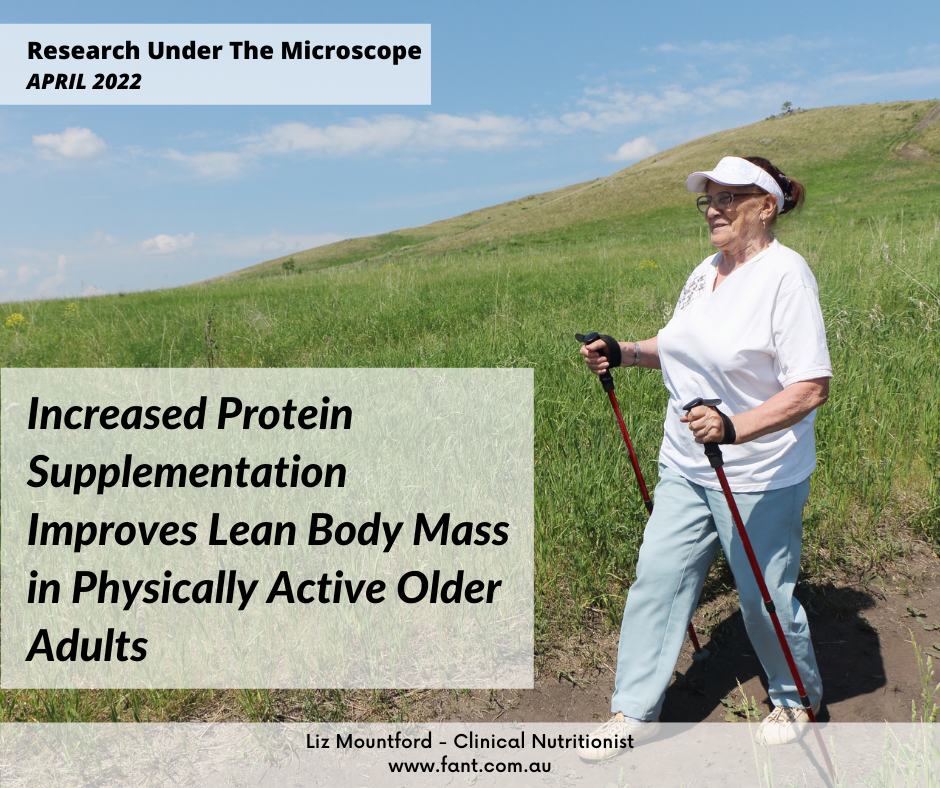Research Under The Microscope Series
The research evidence supporting the use of specific nutrition, diet and food interventions is getting larger all the time and translating new research is often difficult and time consuming. Also, certain research findings such as those from cell or animal studies have limitations when attempting to translate into human clinical practice and must be done with caution.
The aim of “Research Under The Microscope” series is to translate research papers that are quite often technically complicated, extremely lengthy and contain large amounts of data into simple everyday language making it quicker and easier to understand the research findings.
Improvement in Body Composition with Protein Supplementation in Older Active Adults
What is the problem and what is known so far?
The average yearly rate of muscle mass loss in older adults is approximately 1% per year.
- Muscle loss results in health issues such as:
- Weakness
- Increase in falls
- Frailty
- Poor balance
- Movement issues
- Loss of endurance
- Inability to carry out day to day activities such as carrying shopping, standing, and sitting.
However, physically active lifestyles reduce muscle loss and risk of associated health issues. At the same time, getting sufficient protein intake further supports and maintains muscle mass.
What is the background to this research?
This study wanted to see if there were any additional benefits of increasing protein on muscle mass and strength in a group of elderly already active adults.
What was studied in this research?
The researcher wanted to investigate physically active older adults but had a low daily dietary intake of protein.
How was the research performed?
This was a 12-week, two group clinical trial.
Participants were randomly assigned to a treatment group (31 grams extra protein per day in a supplemental form) or placebo. Both groups were given instructions including changes in supplementation if participants exercised on a given day.
What did the study researchers find?
In total, the extra protein group increase protein intake from an average of 0.86 gram per kilogram of body weight per day to 1.29 grams per kilogram of body weight per day.
Body composition was the biggest change after 12 weeks and was observed in both groups. However, the protein group had the greatest change in whole body lean mass (muscle). Over 12 weeks the extra protein group improved their body composition by 1%, offsetting the average annual loss of muscle observed in older adults. Additionally, total fat mass decreased in both groups, but this was significantly more in the extra protein group.
Most of the improvement in body composition was observed in the trunk region, which is associated with better health outcomes.
There was no difference found in muscle strength, muscle contraction or physical performance between the groups bu this may have been due to the fact that it was only a 12 week trial and how the researchers measured strength may not have been sensitive enough to detect the changes. Additionally, even though a person may increase their overall lean body mass, this does not always translate into extra strength due to other health issues a person may have.
Renal function was not impacted by the increase in protein consumption.
What is the take home message?
- Getting enough daily protein is important to help improve overall body composition and help reduce the risk of health issues.
- Exercise is important to prevent muscle loss because:
- It helps increase muscle mass.
- It makes the muscles more sensitive to protein and use the protein more effectively to maintain muscles.
- It suppresses inflammatory chemicals that cause muscle breakdown.
Having protein after physical activity is important to provide muscles with nutrients to help repair, build and maintain muscles. - The current government Recommended Daily Intake (RDIs) for protein in older Australians is outdated and does not consider the latest evidence.
- The RDIs have limitations and are set to be the average intake of protein to meet the nutrient requirements in HEALTHY adults only, and are not for optimum intake for individuals. Factors that need to be considered when reviewing protein intakes can include:
- Activity level
- Health Issues
- Digestive function
- Medications
- Nutrient deficiencies already present
- Protein Sources
What You Can Do Now
Complete a food and activity diary for the week. Record what you eat and the approximate serving sizes, this will help determine how much protein you are eating daily. Additionally, recording your activity can help with changes to when you should be eating protein and if you need to adjust the amount of physical activities
If you need assistance, changes to your diet or nutrition to manage a health condition should only be undertaken with advice from a suitably qualified nutritional health professional.
This factsheet is for general information only.
Please contact me to discuss your individual needs.
References:
- Protein Supplementation Improves Lean Body Mass in Physically Active Older Adults: A Randomized Placebo‐controlled Trial – Haaf – – Journal of Cachexia, Sarcopenia and Muscle – Wiley Online Library’. n.d. Accessed 25 March 2019. https://onlinelibrary.wiley.com/doi/10.1002/jcsm.12394.
- Vipercore-13. 2014. ‘Protein’. Nutrient Page. 17 March 2014. https://www.nrv.gov.au/nutrients/protein.

